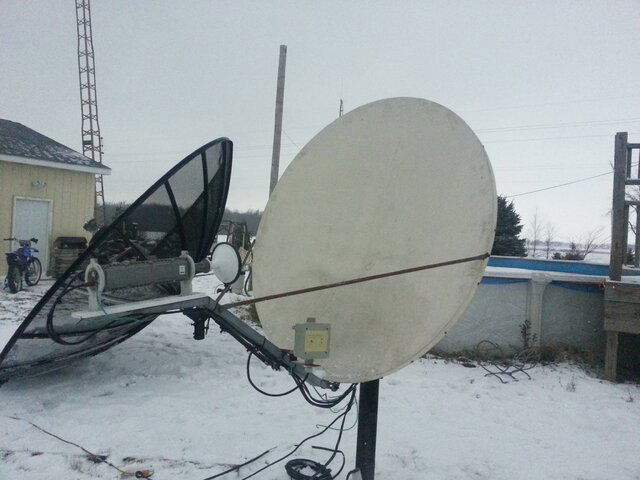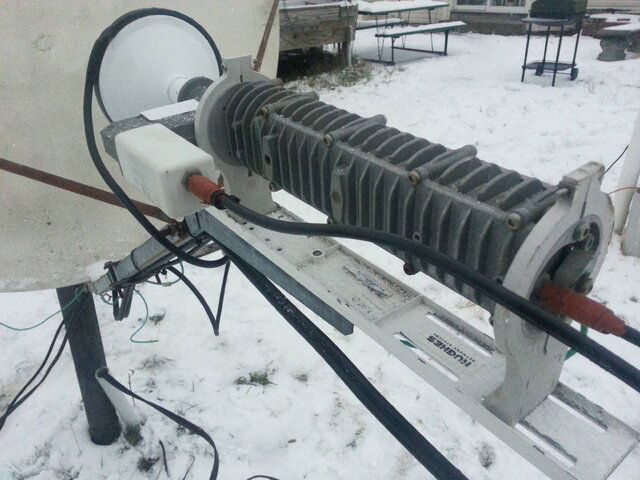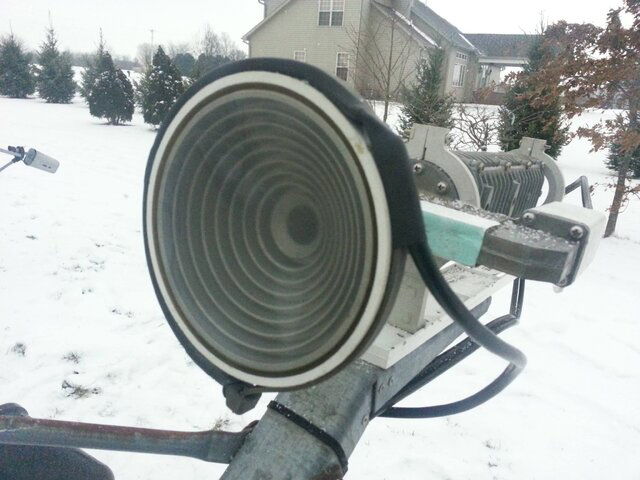Hughes VSAT??
- Thread starter kjsmith01993
- Start date
- Latest activity Latest activity:
- Replies 20
- Views 8K
You are using an out of date browser. It may not display this or other websites correctly.
You should upgrade or use an alternative browser.
You should upgrade or use an alternative browser.
Register to hide this ad
Coming from a gas station, it was probably used for credit card transactions. But it also can be used for satellite internet. You'd have to measure the diameter to make sure, but it's either a 98cm or a 1.2m dish Ku-band dish - likely by Prodelin. Presumably it's a Rx/Tx model, but more info would be needed to determine that. The TRIA appears to be a Hughes OSIRIS/TG2. The current HughesNet modem to use with that combo is the HN7000S. I happen to have one available if you're interested.
And it's not in my character to leave it without saying that you'd likely be better off removing the heat tape from that feedhorn.
//greg//
And it's not in my character to leave it without saying that you'd likely be better off removing the heat tape from that feedhorn.
//greg//
I tried connecting a HN9000 modem to it. all that happened was the power light started flashing blue then after 20 min flashed blue really fast. This modem was working fine when I terminated my service a year ago. It never flashed before.
Well, that doesn't surprise me. The HN9000 is designed to ONLY power a Ka-band system, and has a 73 watt power adapter. The HN7000S modem 64 watt adapter powers various Ku-band systems, including the one you got from the gas station. That's two different power adapters sending several different operating voltages at several different amperages - to their respective outdoor units. You don't mix & match & hope for the best. So in effect you tried to power up a Ku-band system with a Ka-band modem. Hopefully you didn't burn something out.I tried connecting a HN9000 modem to it. all that happened was the power light started flashing blue then after 20 min flashed blue really fast. This modem was working fine when I terminated my service a year ago. It never flashed before.
And those dimensions you provided make it a 1.2m dish.
//greg//
The system light didn't even come on so I'm guessing I didn't. Just wondering why would it be better to remove tape from feedhorn?
Heaters that are not specific to a piece of equipment usually cause more harm than good. Feedhorns seldom ice up anyway, and a cup or two of water usually cleans it off. But a permanently mounted heat tape is a permanently potential source of interference. And interference - at best - slows down the internet connection.
And the fact that the System LED didn't illuminate doesn't mean a thing. It was the incorrect voltages and amperage sent to the ODU that you should worry about.
//greg//
And the fact that the System LED didn't illuminate doesn't mean a thing. It was the incorrect voltages and amperage sent to the ODU that you should worry about.
//greg//
Well, after plugging in the wrong modem - all bets are off. But FYI, here's the LED sequence.
Power - comes on when you power it up
LAN - comes on when you connect a router or a PC to the modem
Receive - comes on when you obtain a usable satellite signal (as defined in the user interface)
Transmit - also defined in the user interface, only comes on once the correct Receive satellite signal is tuned in
System - comes on last once the modem achieves lock with network timing.
The sequence is always Power - Receive - Transmit - System. LAN doesn't rely on the last three, it comes on whenever there's a device plugged into the modem while the Power's on.
//greg//
Power - comes on when you power it up
LAN - comes on when you connect a router or a PC to the modem
Receive - comes on when you obtain a usable satellite signal (as defined in the user interface)
Transmit - also defined in the user interface, only comes on once the correct Receive satellite signal is tuned in
System - comes on last once the modem achieves lock with network timing.
The sequence is always Power - Receive - Transmit - System. LAN doesn't rely on the last three, it comes on whenever there's a device plugged into the modem while the Power's on.
//greg//
I plugged in a router and now all lights flash together. Is this because the dish isn't aimed well enough? I've left it plugged in for an hour.
1. which modem?
2. when you said 7000, did you mean HN7000S or DW7000?
3. do you actually have a working HughesNet account?
4. what changes have you made to the modem user interface?
//greg//
2. when you said 7000, did you mean HN7000S or DW7000?
3. do you actually have a working HughesNet account?
4. what changes have you made to the modem user interface?
//greg//
7000S, no hughes account and I didn't make any changes. I'm just trying to see if it will connect
Assuming the LNB is good, you'll be able to find a Hughes Ku-band RX signal. But that in itself doesn't give you an internet connection. There is the complication of getting the correct RX and TX polarization, which is no simple thing on an OSIRIS/TG2. Even if you stumble upon a satellite and transponder with polarizations that match your current configuration, you won't "connect" with anything until you go through the registration process. Since you don't HAVE a current account to RE-register, the only way to finish the process is to START another account. Unless that's your actual intention, you're just wasting time.
//greg//
//greg//
Heaters that are not specific to a piece of equipment usually cause more harm than good. Feedhorns seldom ice up anyway, and a cup or two of water usually cleans it off. But a permanently mounted heat tape is a permanently potential source of interference. And interference - at best - slows down the internet connection.
And the fact that the System LED didn't illuminate doesn't mean a thing. It was the incorrect voltages and amperage sent to the ODU that you should worry about.
//greg//
That "heat tape as you call it" is designed for this dish. The reflector on the dish has a unit that senses ice build up and kicks a heater on. The tie strap that is around the feed horn is connected to the heating element and deices the LNB. It is perfectly safe and commonly used even in the area I am in "Mississippi" for critical applications like pipeline controllers. In the Northeast they are used on almost everything. I have never known one to cause any type of interference.
Also with that radio unit you have to make sure you are pointing to a transponder that has opposite polarity. For instance H for receive and V for transmit. You might be able to get a signal on a transmitter that is and H H but you will not be able to cross pol. If you are using a vertical receive the ODU will be offset to a 90 deg angle. So if your skew is 10 you will need to add 90 to it. Since the readings on it is only going to be from -90 -- + 90 the correct setting will be around 80 if that makes sense.
You might be ascribing characteristics to this device that don't actually exist. Of course, you can prove me wrong with the tech manual. But the typical VSAT dish heater cannot "sense" the presence of ice. Not that it's impossible, but the cost at the VSAT level would be prohibitive. It's almost certainly controlled by a simple thermal switch. Most of them turn on at +35F and back off at +55F. It doesn't have a clue if actual precipitation is involved.That "heat tape as you call it" is designed for this dish. The reflector on the dish has a unit that senses ice build up and kicks a heater on. The tie strap that is around the feed horn is connected to the heating element and deices the LNB. It is perfectly safe and commonly used even in the area I am in "Mississippi" for critical applications like pipeline controllers. In the Northeast they are used on almost everything. I have never known one to cause any type of interference.
Second; dish heaters are intended for use on metal only. That said, the photos don't reveal the composition of the reflector OR if there are even heat strips on the back side
Third; the never ending heat/cool/heat cycle - particularly in the absence of precipitation - necessarily advances decomposition of the insulation. Decomposing insulation permits the leakage of an electrical field, more than two electrical fields in the vicinity of a VSAT dish constitutes interference.
I don't want to discuss ROTV heaters, as no transmitter is involved. But VSAT heaters are intended for remote/unmanned sites. Military/commercial satellite facilities avoid heaters as well. Dumping the dish and hosing it clean is the preferred method. In extreme conditions radomes are employed, but seldom if ever direct heat. Foisting dish heaters as a "value-added option" on otherwise unsuspecting VSAT customers (who would otherwise use conventional cleaning methods) - may not be criminal. But I definitely consider it unethical.
Oh, and polarization change on an OSIRIS/TGx is accomplished with a 45 degree shim
//greg//
Last edited:
You might be ascribing characteristics to this device that don't actually exist. Of course, you can prove me wrong with the tech manual. But the typical VSAT dish heater cannot "sense" the presence of ice. Not that it's impossible, but the cost at the VSAT level would be prohibitive. It's almost certainly controlled by a simple thermal switch. Most of them turn on at +35F and back off at +55F. It doesn't have a clue if actual precipitation is involved.
Second; dish heaters are intended for use on metal only. That said, the photos don't reveal the composition of the reflector OR if there are even heat strips on the back side
Third; the never ending heat/cool/heat cycle - particularly in the absence of precipitation - necessarily advances decomposition of the insulation. Decomposing insulation permits the leakage of an electrical field, more than two electrical fields in the vicinity of a VSAT dish constitutes interference.
I don't want to discuss ROTV heaters, as no transmitter is involved. But VSAT heaters are intended for remote/unmanned sites. Military/commercial satellite facilities avoid heaters as well. Dumping the dish and hosing it clean is the preferred method. In extreme conditions radomes are employed, but seldom if ever direct heat. Foisting dish heaters as a "value-added option" on otherwise unsuspecting VSAT customers (who would otherwise use conventional cleaning methods) - may not be criminal. But I definitely consider it unethical.
Oh, and polarization change on an OSIRIS/TGx is accomplished with a 45 degree shim
//greg//
Sorry I forgot you where smarter than all the Hughes and Prodelin Engineers.
Yup. I know the stuff exists. But that doesn't change the fact that electric VSAT de-icers are aimed primarily at owners of isolated/unmanned sites and for sites within security areas that are otherwise generally inaccessible after installation. Site owners should also understand that - when energized - they must be willing to sacrifice some performance for the sake of convenience.
//greg//
//greg//
Similar threads
- Replies
- 23
- Views
- 5K
- Replies
- 2
- Views
- 1K
- Replies
- 1
- Views
- 1K
Users Who Are Viewing This Thread (Total: 0, Members: 0, Guests: 0)
Who Read This Thread (Total Members: 3)
Latest posts
-
T
-
T
-
TMicrosoft’s New AI Avatar: Is Mico the Next Clippy?
- Latest: TWiT Tech Podcast Network
-




